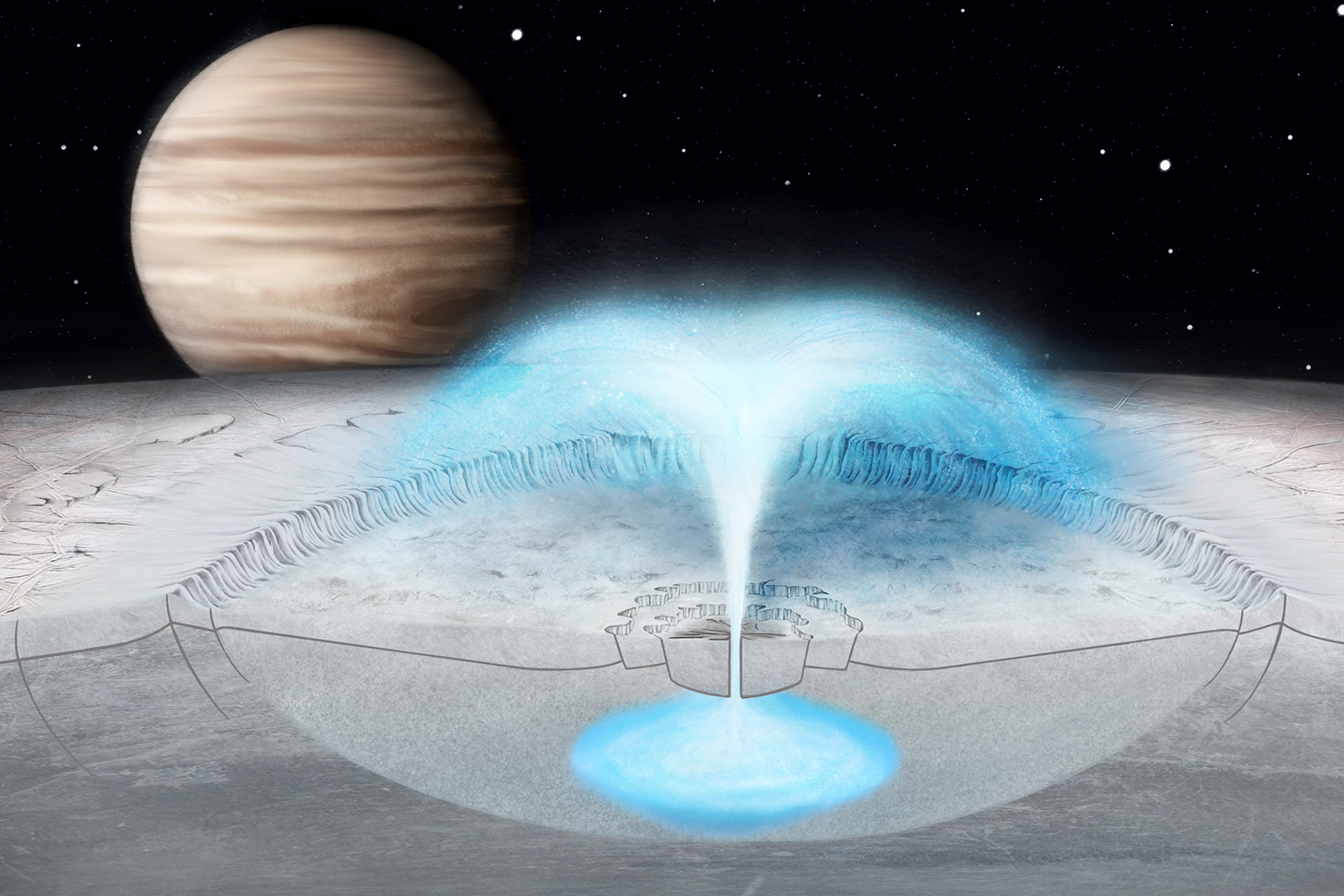Where the geysers on Europa could come from
There are several worlds – usually moons – in the solar system, where it appears that life-friendly conditions could exist in the oceans below their crust. Whether this is really the case, we will only know after we have drilled through the ice and checked (as is done in The Enceladus Mission). A new paper by researchers from Stanford University, the University of Arizona, the University of Texas and NASA’s Jet Propulsion Laboratory is now lowering hopes somewhat. As the researchers show, some eruptions may not come from the depths of the oceans, but from water pockets embedded in the ice sheet of Europa.
Using images collected by NASA’s Galileo spacecraft, the researchers developed a model to explain how a combination of freezing and pressurization could lead to a cryovolcano eruption or a water eruption. The results, which were published in Geophysical Research Letters on November 10, have implications for the habitability of the underlying ocean – and could explain geysers on other ice bodies in the solar system. Indeed, if the steam plumes originate from the icy bowl of the moon, they may be less life-friendly because it is more difficult to obtain the chemical energy needed to fuel life there. In this case, the chances of determining habitability from space are also reduced.
«Understanding where these water fountains come from is very important to know whether future researchers on Europa might have a chance to discover life from space without exploring the Europa ocean themselves,» says lead author Gregor Steinbrügge. The researchers concentrated their analyses on Manannán, a 30 kilometer wide crater on Europa, which was formed by an impact with another celestial object several tens of millions of years ago. On the grounds that such a collision would have generated an enormous amount of heat, they modelled how the melting and subsequent freezing of a water pocket in the ice cover could have caused the water to erupt as a geyser.
«The comet or asteroid that hit the ice shell was basically a big experiment that we use to make hypotheses to test them,» says co-author Don Blankenship. The model suggests that if the water of Europa turns to ice in the later stages of the impact, water pockets with increased salinity could form on the lunar surface. In addition, these saline water pockets may migrate sideways through the ice sheet of Europa as neighboring regions with less brackish ice melt, making them even saltier.
«We have found a method that allows a water hole to move sideways – and this is very important,» says Steinbrügge. «It can move along thermal gradients from cold to warm, and not just downwards, as gravity does. The model also describes how a migrating brine pocket reaches the center of the Manannán crater, gets stuck there and begins to freeze, creating pressure that eventually leads to the eruption of a mile-high steam cloud. The eruption of this plume left behind a distinctive feature: a spider-shaped feature on the surface of Europa, which was observed by the Galileo camera and incorporated into the researchers’ model.
«Even if the steam plumes caused by the migration of the brine pockets would not provide a direct view into the ocean of Europa, our results indicate that the ice shell of Europa itself is very dynamic,» says co-author Joana Voigt. Moreover, the researchers are not yet taking away all hope from the upcoming expeditions. The relatively small size of the plume that would form at Manannán suggests that impact craters probably cannot explain the source of other, larger geysers on Europa, which were hypothetically assumed on the basis of Hubble and Galileo data, the researchers say. But the process modeled for Manannán’s eruption could also occur on other icy bodies – even without an impact event.
The study also provides estimates of how salty Europa’s frozen surface and ocean could be, which in turn could affect the transparency of the ice shell for radar waves. The calculations, based on Galileo’s images from 1995 to 1997, show that Europa’s ocean could be about one-fifth as salty as the Earth’s ocean – a factor that will improve the ability of the Europa Clipper mission’s radar probe to collect data from the interior of the ocean.
